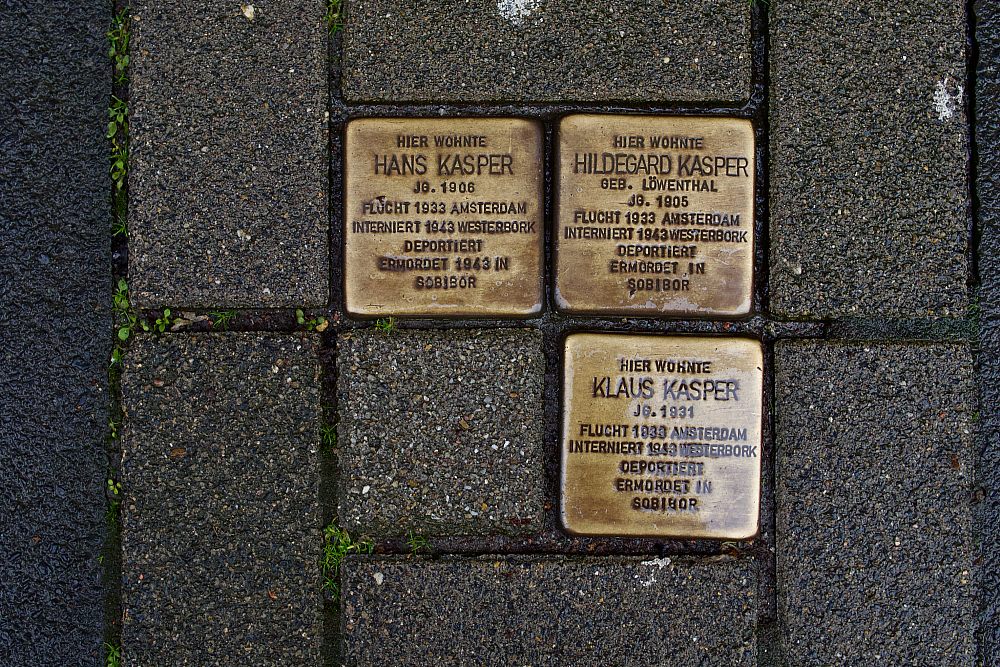Stumbling Stones Sternbuschweg 12
These small, brass, memorial plaques (Stolpersteine or stumbling stones) commemorate 3 members of the Kasper family:
* Hans Kasper, born 1906, fled 1933 Amsterdam, interned 1943 Westerbork, deported, murdered 1943 in Sobibor.
* Hildegard Kasper née Löwenthal, born 1905, fled 1933 Amsterdam, interned 1943 Westerbork, deported, murdered in Sobibor.
* Klaus Kasper, born 1931, fled 1933 Amsterdam, interned 1943 Westerbork, deported, murdered in Sobibor.
Background
Hans Kasper, a merchant, and Hildegard Löwenthal married. Some sources (including the stolpersteine at this location) suggest that they had only one son – Klaus, born 1931 in Duisburg. Other sources mention a second son, Walter, born 1936 in Rotterdam. Information on Hans, Hildegard, and Klaus Kasper show that they fled to Amsterdam in 1933, were interned in Westerbork from April until 6 July 1943, when were deported from Westerbork. They were murdered in Sobibor 3 days later.
According to Joods Monument and Open Archives NL, Walter Kasper, age 6, was also murdered in Sobibor on the same day – 9 July 1943.
Hans Kasper’s parents, Julius and Olga Kasper, and his sister Ruth fled in 1933 to Rotterdam, but all three were killed by the Nazis in 1943. Stolpersteine for Julius, Olga, and Ruth Kasper can be seen at Ludgeristraße 21 in Duisburg.
"Stolpersteine" is an art project for Europe by Gunter Demnig to commemorate victims of National Socialism (Nazism). Stolpersteine (stumbling stones) are small, 10x10cm brass plaques placed in the pavement in front of the last voluntary residence of (mostly Jewish) victims who were murdered by the Nazis. Each plaque is engraved with the victim’s name, date of birth, and place (mostly a concentration camp) and date of death. By doing this, Gunter Demnig gives an individual memorial to each victim. One stone, one name, one person. He cites the Talmud: "A human being is forgotten only when his or her name is forgotten."
Do you have more information about this location? Inform us!
Source
- Text: Fedor de Vries & Anne Palmer
- Photos: Peter Wölver
- Joods Monument
- Yad Vashem Central Database of Shoah Victims’ Names
- Stolpersteine in Duisburg, Band II, p.18
- Open Archives NL: Walter Kasper
- Stolpersteine.eu
Nearby
Museum
Point of interest
Monument
- Memorial German Unionists - Duisburg
- Memorial Catholic Association - Duisburg
- Memorial Gottfried Könzgen - Duisburg
Cemetery
- Kaiserberg German War Cemetery - Duisburg
- War Graves Friedhof Sternbuschweg - Duisburg
- German War Cemetery Uhlenhorst - Mülheim an der Ruhr




